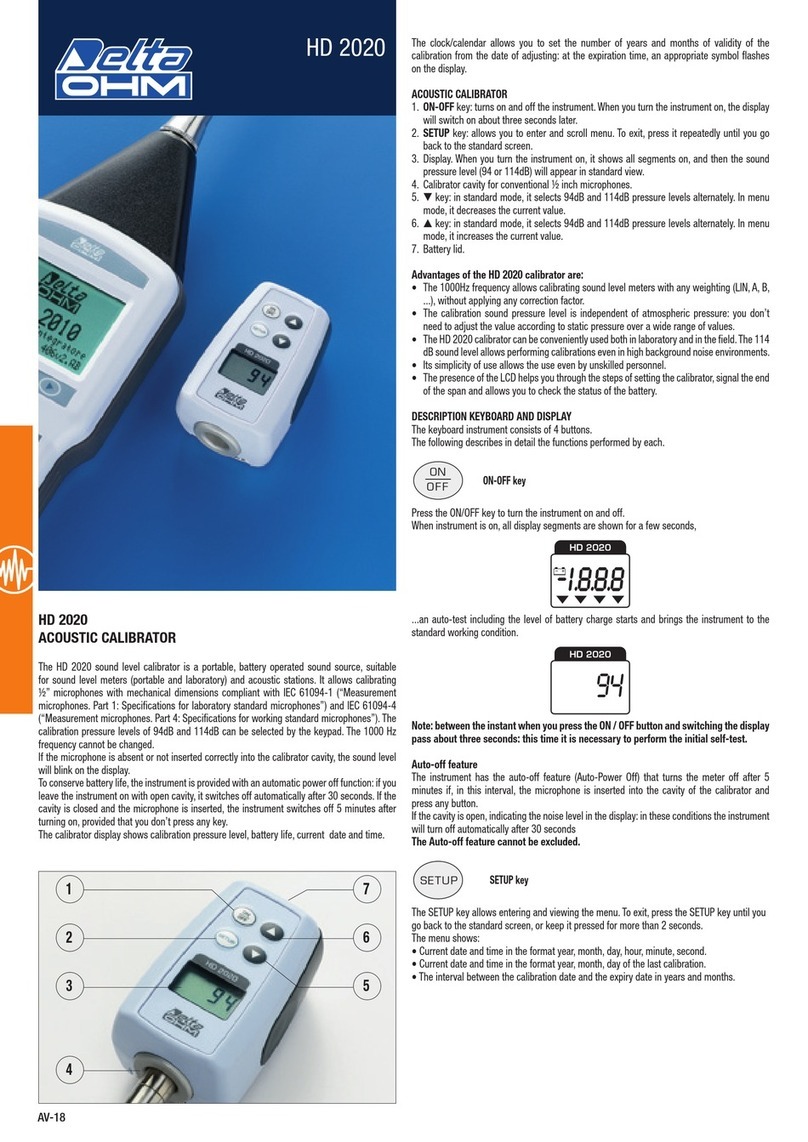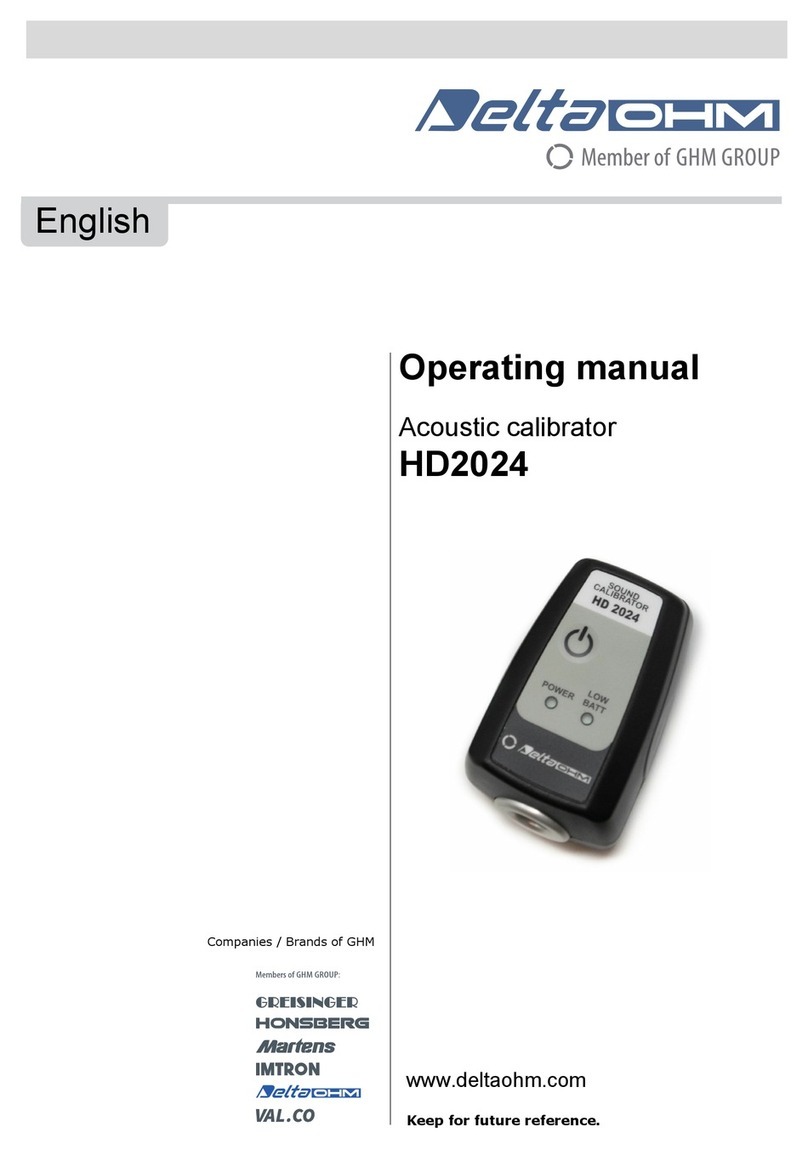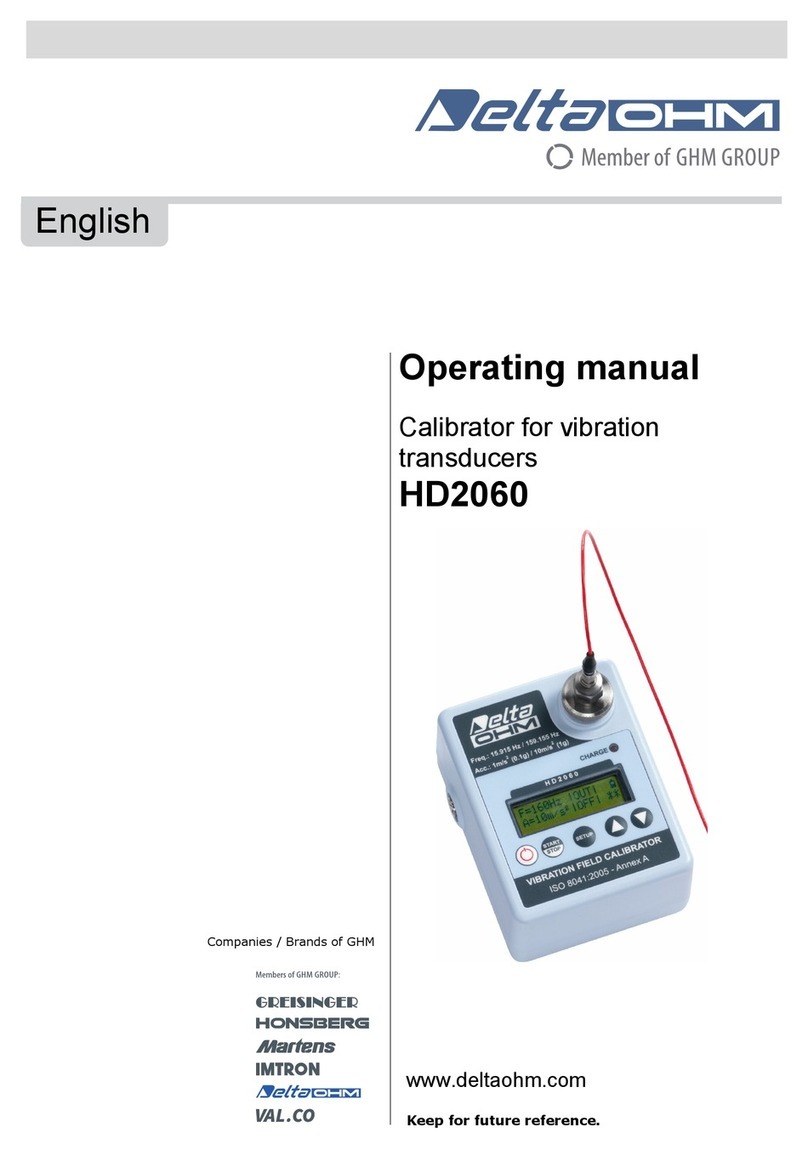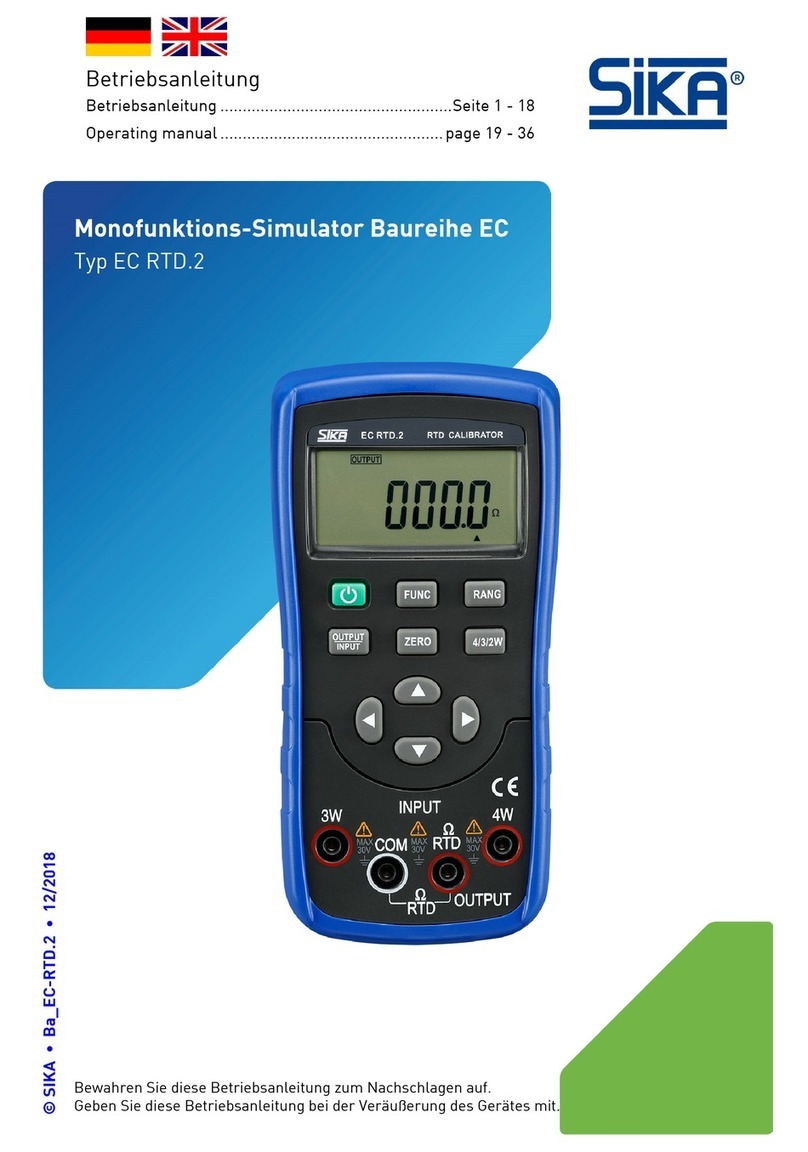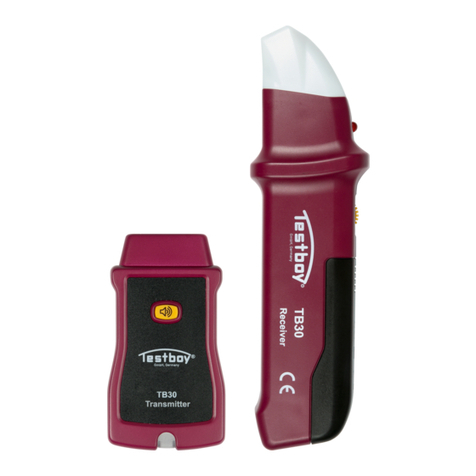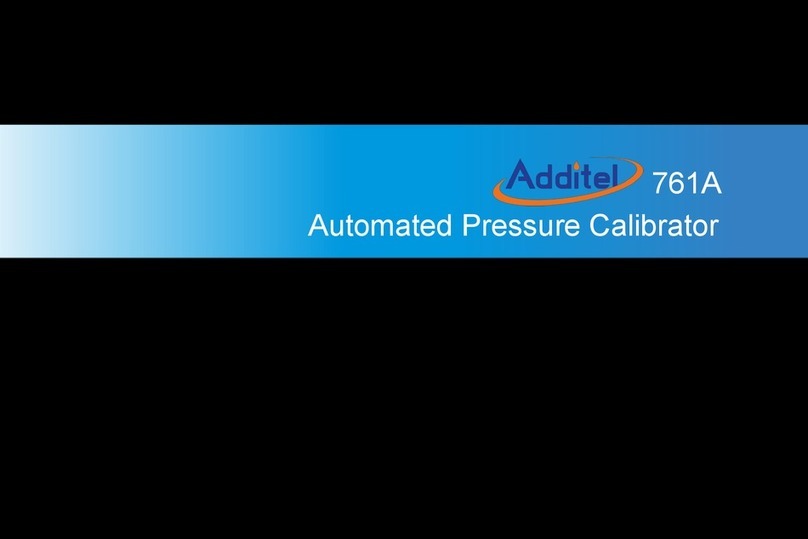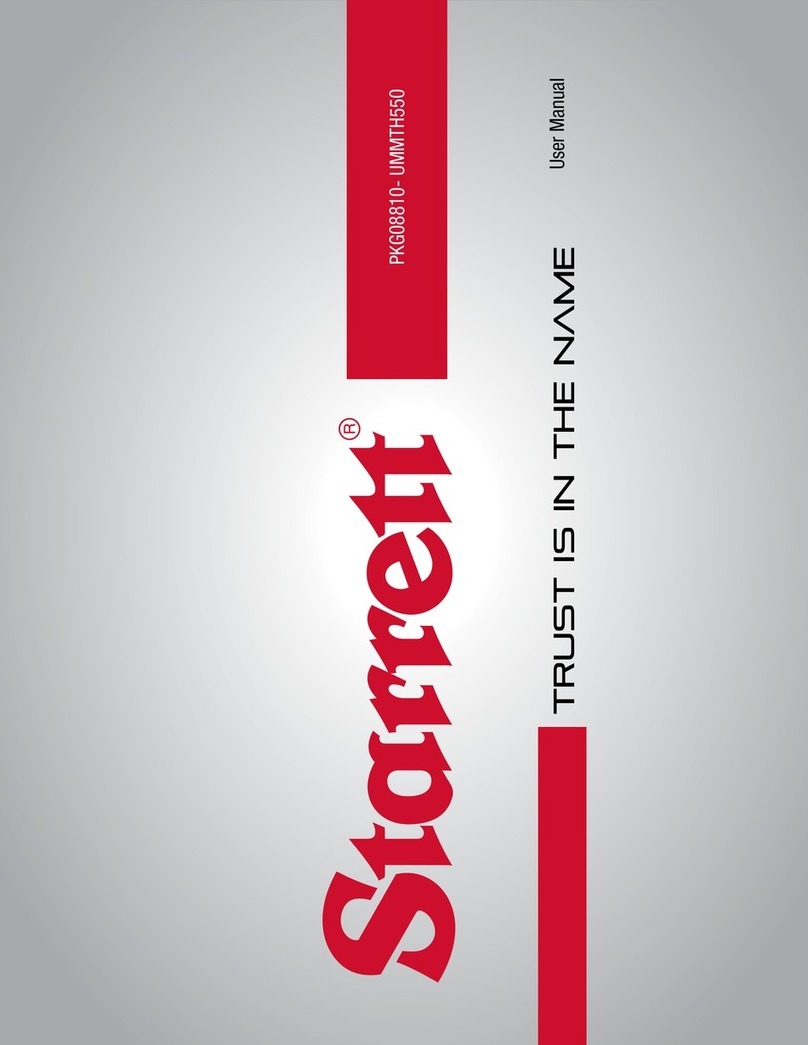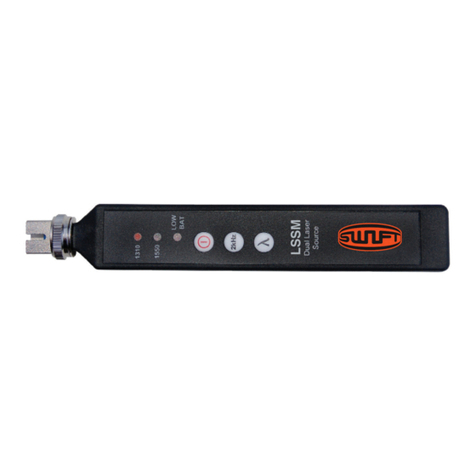Delta OHM HD 2020 User manual

Our instruments' quality level is the result of the product continuous development. This can bring about dif-
ferences between information written in this manual and the instrument that you have purchased. We cannot
entirely exclude errors in the manual, for which we apologize.
Data, figures and descriptions contained in this manual cannot be legally asserted. We reserve the right to
make changes and corrections without prior notice.
REV. 1.1
15th June 2012
HD 2020
ENGLISH

--
2
HD 2020
Acoustic calibrator
1. ON-OFF key: turns on and off the instrument. When you turn the instrument on, the display will switch
on about two seconds later.
2. SETUP key: allows you to enter and scroll menu. To exit, press it repeatedly until you go back to the
standard screen.
3. Display. When you turn the instrument on, it shows all segments on, then the sound pressure level (94
or 114dB) will appear in standard view.
4. Calibrator cavity for 1/2 inch microphones.
5. key: in standard mode, it selects 94dB and 114dB pressure levels alternately. In menu mode, it de-
creases the current value.
6. key : in standard mode, it selects 94dB and 114dB pressure levels alternately. In menu mode, it in-
creases the current value.
7. Battery lid.

--
3
CERTIFICATO DI CONFORMITÀ DEL COSTRUTTORE
MANUFACTURER’S CERTIFICATE OF CONFORMITY
rilasciato da
issued by
DELTA OHM SRL STRUMENTI DI MISURA
DATA
2012/06/15
DATE
Si certifica che gli strumenti sotto riportati hanno superato positivamente tutti i test di
produzione e sono conformi alle specifiche, valide alla data del test, riportate nella
documentazione tecnica.
We certify that below mentioned instruments have been tested and passed all production tests,
confirming compliance with the manufacturer's published specification at the date of the test.
Le misure effettuate presso un Laboratorio di Taratura Accredia sono garantite da una
catena di riferibilità ininterrotta, che ha origine dalla taratura dei campioni di prima linea
del Laboratorio presso l’istituto metrologico nazionale.
Measurements performed in an Accredia Calibration Laboratory are guaranteed by a uninter-
rupted reference chain which source is the calibration of the Laboratory first line standards at the
national metrological institute.
Tipo Prodotto:
Calibratore acustico
Product Type:
Acoustic calibrator
Nome Prodotto:
HD2020
Product Name:
DELTA OHM SRL
35030 Caselle di Selvazzano (PD) Italy
Via Marconi, 5
Tel. +39.0498977150 r.a. - Telefax +39.049635596
Cod. Fisc./P.Iva IT03363960281 - N.Mecc. PD044279
R.E.A. 306030 - ISC. Reg. Soc. 68037/1998

--
4
INTRODUCTION
The HD 2020 sound level calibrator is a portable, battery operated sound source, suitable
for sound level meters (portable and laboratory) and acoustic stations.
It allows calibrating 1/2” microphones with mechanical dimensions compliant with IEC
61094-1 (“Measurement microphones. Part 1: Specifications for laboratory standard mi-
crophones”) and IEC 61094-4 (“Measurement microphones. Part 4: Specifications for
working standard microphones”).
The calibration pressure levels of 94dB and 114dB can be selected by the keypad. The
1000 Hz frequency cannot be changed.
If the microphone is absent or not inserted correctly into the calibrator cavity, the sound
level will blink on the display.
To conserve battery life, the instrument is provided with an automatic power off function: if
you leave the instrument on with open cavity, it switches off automatically after 30 sec-
onds. If the cavity is closed and the microphone is inserted, the instrument switches off 5
minutes after turning on, provided that you don’t press any key.
The calibrator display shows calibration pressure level, battery life, current date and time.
The internal clock allows to set up the validity period of calibration, expressed in years and
months, starting from the date of adjustment: as soon as the time interval has elapsed, a
blinking symbol alerts to make a new adjustment.
The HD 2020 calibrator advantages are:
The 1000Hz frequency allows calibrating sound level meters with any weighting (LIN,
A, B, ...), without applying any correction factor.
The calibration sound pressure level is indipendent of atmosferic pressure: you don’t
need to adjust the value according to static pressure over a wide range of values.
The HD 2020 calibrator can be conveniently used both in laboratory and in the field.
The 114 dB sound level allows performing calibrations even in high background noise
environments.
Its simplicity of use allows even unqualified staff to employ it.
The LCD makes easy to setup the calibrator, signals the calibration expiry and allows
to control the level battery.

--
5
DISPLAY AND KEYPAD DESCRIPTION
The instrument keypad is composed of 4 keys.
Listed below are their main functions.
ON-OFF key
Press the ON/OFF key to turn on and off the instrument.
When you turn the instrument on, all the display segments are shown, for a few seconds ...
... an automatic test including battery power is performed and the instrument switches to standard mode.
Note: the display turns on 3 seconds after you press the ON/OFF key: meanwhile, the initial auto-
matic test is performed.
AutoPowerOff function
The instrument is provided with an automatic power off function which switches off the instrument after about
5 minutes if the microphone is inserted in the cavity and you don’t press any key.
If the cavity is open, the sound level blinks on the display: in this case the instrument switches off automati-
cally after 30 seconds.
You cannot disable the AutoPowerOff function.
SETUP Key
The SETUP key allows entering and viewing the menu. To exit, press the SETUP key until you go back to
the standard screen or press the key down for more than two second.
The menu shows:
•Current date and time in the format year, month, day, hour, minute, second.
•The interval between the calibration date and the expiry date in years and months.
You can set all these items: press SETUP to select it and use the arrow keys to change it.
Press the SETUP key to confirm.
From the standard screen, press the SETUP key to view the current year:
>>
>>

--
6
Use the arrow keys to increase/decrease the value. Press the SETUP key to confirm and go to the current
month:
>>
Use the arrow keys to increase/decrease the value. Press the SETUP key to confirm and go to the current
day:
>>
Use the arrow keys to increase/decrease the value. Press the SETUP key to confirm and go to the current
time:
>>
Use the arrow keys to increase/decrease the value. Press the SETUP key to confirm and go to the current
minute:
>>
Use the arrow keys to increase/decrease the value. Press the SETUP key to confirm and go to the current
second:
>>
Whenever you press the arrow keys, seconds will be reduced to zero. Press the SETUP key to confirm and
go to calibration section of the menu: the first triangle on the left turns on and the calibration year appear
(this parameter cannot be modified by the user).
(calibration year –first triangle)

--
7
Pressing the SETUP key, calibration month appears (the parameter cannot be modified by the user).
(calibration month –first triangle)
Pressing the SETUP key, calibration day appears (the parameter cannot be modified by the user).
(calibration day –first triangle)
Pressing the SETUP key you can proceed to the expiration date of the calibration; the second triangle from
the left switches on and the number of years of calibration validity appear. You can enter the number of
years and months between the calibration date, which is entered by the calibration laboratory, and the expiry
date. When the time interval expires, the triangle blinks to remind you that the calibrator needs a new ad-
justment.
(years of validity –second triangle)
Use the arrow keys to increase/decrease the value. Confirm with SETUP key and go on to the number of va-
lidity months.
(months of validity–second triangle)
Use the arrow keys to increase/decrease the value. Confirm with SETUP key and go back to standard view.
Arrow key
In standard mode, it selects 94dB and 114dB sound pressure levels alternately. In menu mode, it increases
the current value.
Arrow key
In standard mode, it selects 94dB and 114dB sound pressure levels alternately. In menu mode, it decreases
the current value.

--
8
CALIBRATION PROCEDURE
The HD 2020 can calibrate standard 1/2” microphones compliant with IEC 61094-1 and IEC61094-2.
To calibrate the microphone, insert it deep into the cavity. The O-ring will offer some resistance.
During calibration the HD2020 can be held in vertical position or placed on a flat surface.
While measuring, you should move neither the microphone nor the calibrator; make sure that the worktable
doesn’t transmit vibrations.
A small misalignment of the microphone and calibrator axes is allowed.
•Before beginning to calibrate, you should make sure that the ambient noise level doesn’t affect
the calibration. After inserting the microphone into the cavity, with the sound level meter and the
calibrator off, switch on the sound level meter and detect the unweighted ambient sound pressure
level. If the measured level is below 78 dB, you can use both calibration sound levels (94 dB and
114 dB); if the level is between 78 dB and 98 dB you can use the 114 dB level only, while a sound
level above 98 dB means that calibration is not possible.
•Press the ON/OFF key to switch on the instrument.
•Use the arrow keys to select the sound level: 94 dB or 114 dB.
•Make sure that the measurement value is not blinking on the display: this means that the micro-
phone is not inserted correctly.
•Calibrate the sound level meter as per the procedure shown in the instrument manual.
•Apply the correction to the pressure level depending on the microphone (see the following chap-
ter).
•Once calibration is complete, switch off the sound level meter and the calibrator and remove the
microphone from the cavity.

--
9
The HD 2020 calibrator allows calibrating any sound level meter provided that it is equipped with a labora-
tory or working standard 1/2” microphone compliant with IEC 61094-01 and IEC 61094-4 standards.
Corrections depending on the microphone
The HD2020 calibrator generates a 94 dB (or 114 dB) sound pressure level referred to 20μPa. Working
standard ½” microphones for sound level meters are manufactured to achieve flat frequency response in
free or diffuse field, i.e. in a field of progressive plane waves propagating in the same direction as the micro-
phone axis and in a field of sound waves coming from every direction, respectively. These propagation con-
ditions are different from those in the calibrator cavity.
In free field, reflections due to the microphone alter the sound level by increasing the high-frequency car-
tridge effective sensitivity. Microphones optimized for free field measurements exploit this phenomenon to
achieve flat frequency response even at very high frequencies. In these microphones, the sound level in-
crease at 1 kHz corresponds to approximately 0.05 dB ÷ 0.20 dB. Therefore, when you calibrate a free field
microphone, you must allow for this difference when you set a sound level 0.1 dB or 0.2 dB lower than the
calibrator nominal one.
Microphones optimized for diffuse field measurements don’t require corrections when calibrated in a closed
cavity at 1 kHz instead.
LOW BATTERY INDICATION AND REPLACEMENT
The HD 2020 calibrator is provided with two batteries: a 9V alkaline battery that can be replaced by the user
and a lithium buffer battery. The latter allows the date indicator and watch to work even without external bat-
tery: it must be replaced by a Delta Ohm authorized service centre.
The 9V battery power is constantly monitored:
•If the battery is fully charged, its symbol is off;
•If the battery is partially charged, its symbol blinks: please replace the battery as soon as possible;
•If the battery is uncharged and the instrument cannot work properly, its symbol is constantly on. When the
battery is uncharged, the calibrator switches off in about 10 seconds.
To replace 9V batteries, switch off the instrument and open the lid at the bottom of the instrument. Replace
the battery. Close the lid.
Date, time and calibration interval are stored if the buffer battery is charged.
The average life of the buffer battery depends on the external battery: if you use it, the average life of the in-
ternal battery is about 5 years.
Battery tips
Remove the battery if the instrument is not to be used for an extended period. If the battery is low,
replace it as soon as possible.
Make sure that there is no loss of liquid.
Use good quality sealed batteries (alkaline if possible).

--
10
CONSTRUCTION AND FUNCTIONING
Mechanical construction
Fig. 3 Calibrator mechanical construction (section).
Fig. 3 schematizes the HD 2020 calibrator structure (section). The battery compartment is on the right side of
the case. The printed circuits and the electronics are over and under the battery compartment. The display
and the keypad take up the higher part. The electro-acoustic transduction device is on the left and it consists
of a wide cavity with a piezoceramic generator and a feedback sensor. The device emits the signal through
the ½” microphone. An outer capillary hole balances the chamber static pressure protecting microphones
from overpressure due to their insertion.
Control electronics
Fig. 4 shows the calibrator block diagram.
Fig. 4 Electronics block diagram.

--
11
The electronics consist mainly of an oscillator combining high stability and low distortion, as well as an RMS
converter, the automatic gain control (AGC), the driver for the ceramic resonator and the feedback signal
conditioning.
The RMS level of the signal provided by the sensor is compared with the factory set reference level; the dif-
ference adjusts the signal width generated by the oscillator and thus the acoustic signal generated by the
piezoelectric transducer through automatic gain control.
The signal provided by the sensor slightly varies with the ambient temperature and the static pressure; the
frequency of the signal provided by the oscillator is also stable in relation to ambient parameters.
INSTRUMENT STORAGE
Instrument storage conditions:
Temperature: -25...+55°C.
Humidity: below 90% RH without condensation.
When storing the instrument, avoid:
High humidity.
Direct exposure to sunlight.
Exposure to high-temperature source.
Strong vibration.
Steam, salt and/or corrosive gas.
The instrument case is made of ABS: please use only compatible solvents to clean it.

--
12
FUNCTIONING AND OPERATING SAFETY
Authorized use
Please read carefully the specifications listed in the following chapter. You are allowed to use the instrument
only in compliance with these instructions. Any other use is not authorized.
General safety instructions
This instrument is manufactured and tested in compliance with EN 61010-1 safety standard on electronic
measuring instruments and it leaves the factory in perfect safety conditions.
Normal functioning and operating safety are guaranteed only if all usual and specific safety standards de-
scribed in this manual are observed.
Normal functioning and operating safety are guaranteed only if climatic conditions are the same as described
in the “specifications” chapter.
Use and store the instrument avoiding:
Sudden change of the ambient temperature that may cause condensation.
Inflammable or corrosive gases.
Direct vibration or blows.
Intense electromagnetic fields, static electricity.
If you carry the instrument from a cold to a hot environment, condensation may affect its functioning. In this
case you should wait for the instrument temperature to reach the ambient temperature before using it again.
User obligations
The user must comply with the following standards and directives on the use of dangerous materials:
EEC directives on safety in the workplace
National legislation on safety in the workplace
Safe working practices

--
13
SPECIFICATIONS
The HD 2020 calibrator complies with IEC 60942-2003 Class 1 and ANSI S1.40-1984.
Coupling cavity: for standard 1/2” microphones (12.7 ± 0.03 mm) ac-
cording to IEC 61094-1 and IEC 61094-4
Frequency: 1000 Hz
Frequency tolerance: 1% in the range -10...+50°C and 10%...90%RH
Sound pressure level: 94.0 dB and 114.0 dB ±0.2 dB at 1kHz
(referred to 101.3 kPa, 23°C ±3°C and 65% R.H.)
Reference conditions: 20°C, 50% RH, 101.3kPa, 10 mm3 cartridge volume
Stabilization time: 10s
Total distortion: <1%
Ambient condition influence
Temperature and humidity influence: < 0.3 dB in the range -10°C...50°C and 10%...90%RH
Static pressure influence: < 0.1 dB in the range 65 kPa ... 108 kPa
Stability levels
Short-term stability: ±0.03 dB
Stability after 1 year, normal use: ±0.1 dB
Operating conditions
Working temperature: -10 … +50°C
Relative humidity: ≤90% R.H.
Storage temperature: -25 … +70°C
Microphone equivalent volume: 5 to 250 mm3
Power supply: 9V alkaline battery IEC type 6LR61. 9V rechargeable
batteries are also allowed.
9V battery autonomy: 48-hour continuous functioning with good quality alka-
line batteries.
Automatic power off: 5 minutes –it cannot be disabled
Display 3½ digit LCD, battery symbol
Watch/date-indicator: internal with 3V lithium buffer battery
Case material: ABS
Dimensions: 53x43x83mm
Weight: 160g.
IP Protection degree IP64
Effects of electromagnetic fields: < 0.3 dB

--
14
ORDERING CODE
HD2020 The kit includes: HD2020 calibrator, one 9V alkaline battery, instruction manual and I-
SO 9001 calibration report.

--
15
CONTENTS
INTRODUCTION ............................................................................................................................................... 4
DISPLAY AND KEYPAD DESCRIPTION......................................................................................................... 5
CALIBRATION PROCEDURE.......................................................................................................................... 8
LOW BATTERY INDICATION AND REPLACEMENT..................................................................................... 9
CONSTRUCTION AND FUNCTIONING......................................................................................................... 10
INSTRUMENT STORAGE .............................................................................................................................. 11
FUNCTIONING AND OPERATING SAFETY................................................................................................ 12
SPECIFICATIONS........................................................................................................................................... 13
ORDERING CODE.......................................................................................................................................... 14

--
16
GUARANTEE
GUARANTEE CONDITIONS
All DELTA OHM instruments have been subjected to strict tests and are guaranteed for 24 months from
date of purchase. DELTA OHM will repair or replace free of charge any parts which it considers to be inef-
ficient within the guarantee period. Complete replacement is excluded and no request of damages are rec-
ognized. The guarantee does not include accidental breakages due to transport, neglect, incorrect use, in-
correct connection to voltage different from the contemplated for the instrument. Furthermore the guaran-
tee is not valid if the instrument has been repaired or tampered by unauthorized third parties. The instru-
ment has to be sent to the retailer without transport charge. For all disputes the competent court is the
Court of Padua.
The electric and electronic devices with the following symbol cannot be disposed in the public
dumps. According to the Directive UE 2002/96/EC, the European users of electric and electronic
devices are allowed to give back to the Distributor or Manufacturer the used device at the time of
purchasing a new one. The illegal disposing of electric and electronic devices is punished by a
pecuniary administrative penalty.
This guarantee must be sent together with the instrument to our service centre.
N.B.: Guarantee is valid only if coupon has been correctly filled in all details.
Instrument type
HD 2020
Serial number
RENEWALS
Date
Date
Inspector
Inspector
Date
Date
Inspector
Inspector
Date
Date
Inspector
Inspector
C E C O N F O R M I T Y
Safety
EN61010-1
Electromagnetic compatibility. Immunity general standard
EN61000-6-2:2005
Electromagnetic compatibility. Emission general standard
EN61000-6-3:2007
Electrostatic Discharge Immunity
EN61000-4-2 level 3
Susceptibility to electromagnetic interference
EN61000-4-3 level 3
Immunity to electrical fast transients
EN61000-4-4 level 3
Immunity to conducted disturbances
EN61000-4-6
Electromagnetic Interference - Conducted Emissions
EN55022:2007 class B
Electromagnetic Interference - Irradiated Emissions
IEC/CISPR 22 class B
Other manuals for HD 2020
2
Table of contents
Other Delta OHM Test Equipment manuals
Popular Test Equipment manuals by other brands

Paul
Paul thermos 300 DC operating instructions
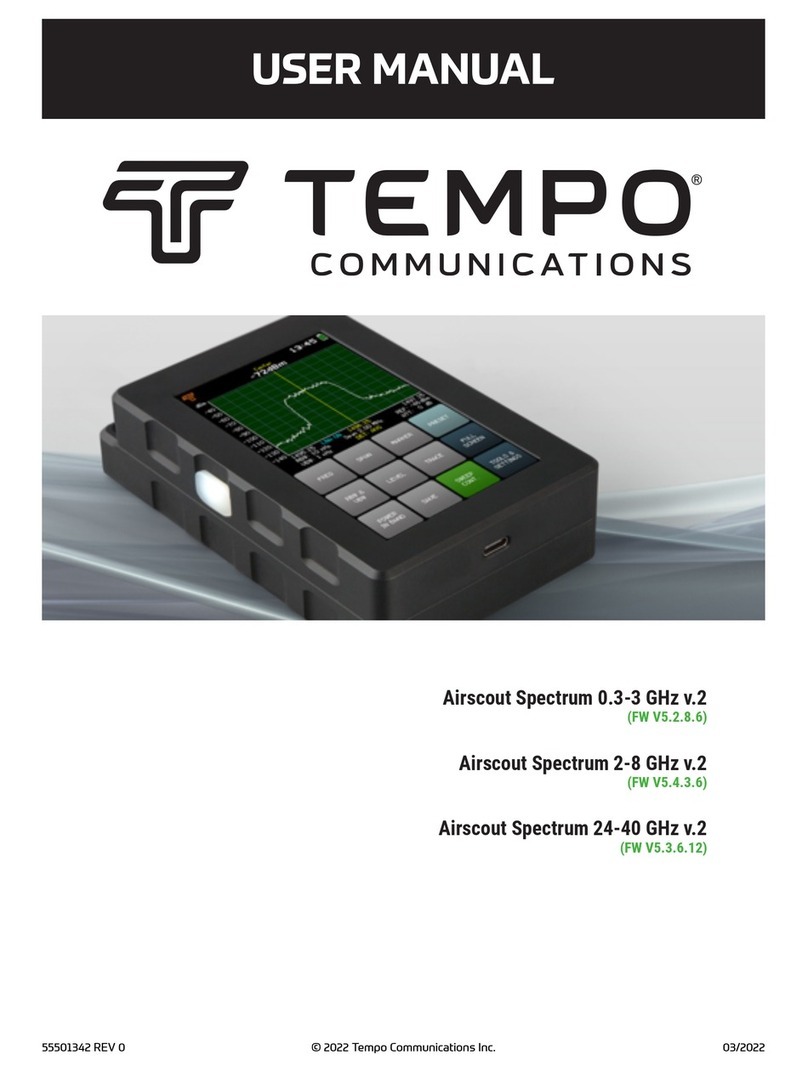
Tempo Fitness
Tempo Fitness Airscout Spectrum ASPEC03BK user manual
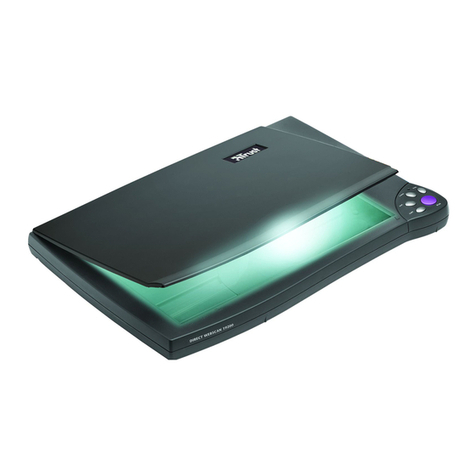
Trust
Trust DIRECT WEBSCAN 19200 instruction manual
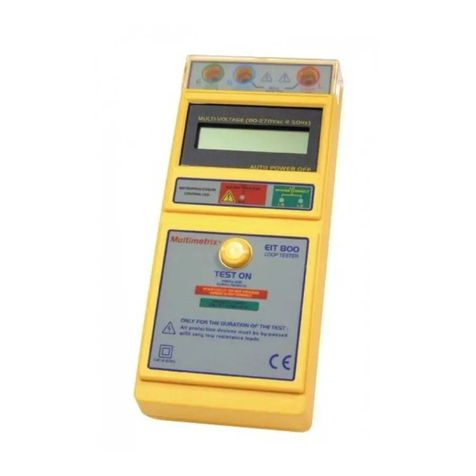
Chauvin Arnoux
Chauvin Arnoux Multimetrix EIT 800 user manual

THOMSON
THOMSON DFT-6102 user manual
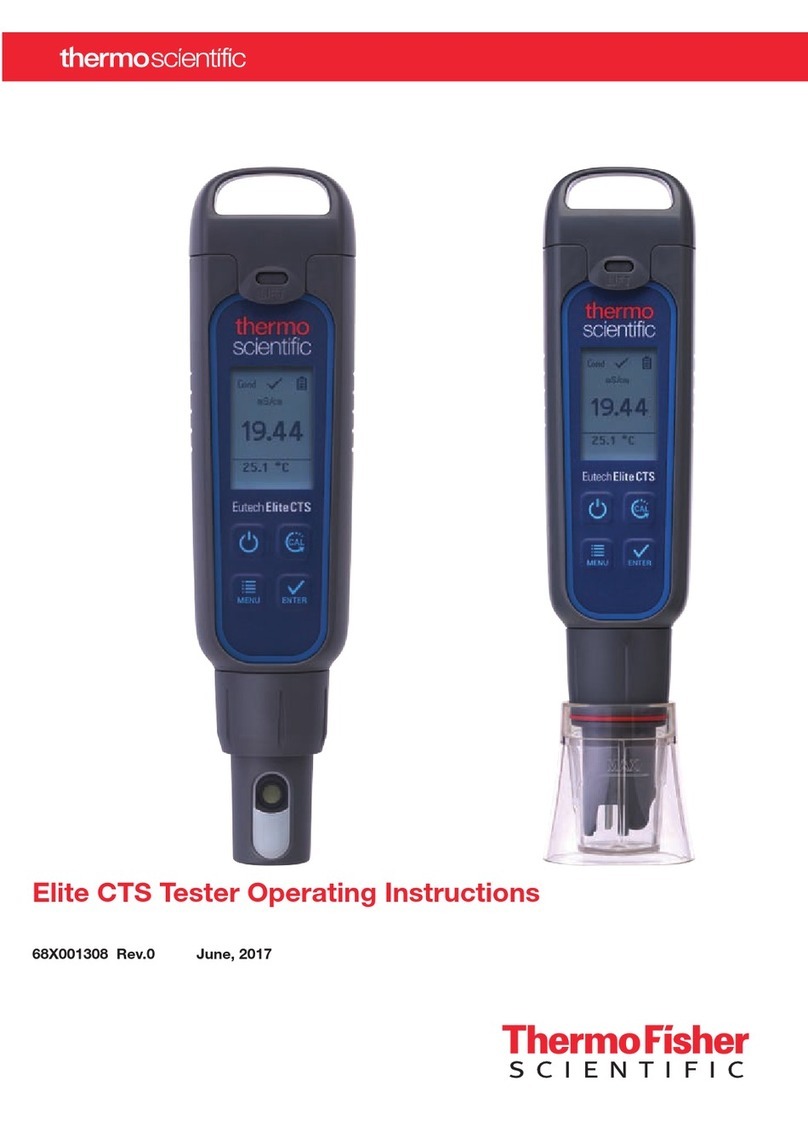
Thermo Scientific
Thermo Scientific Elite CTS operating instructions
